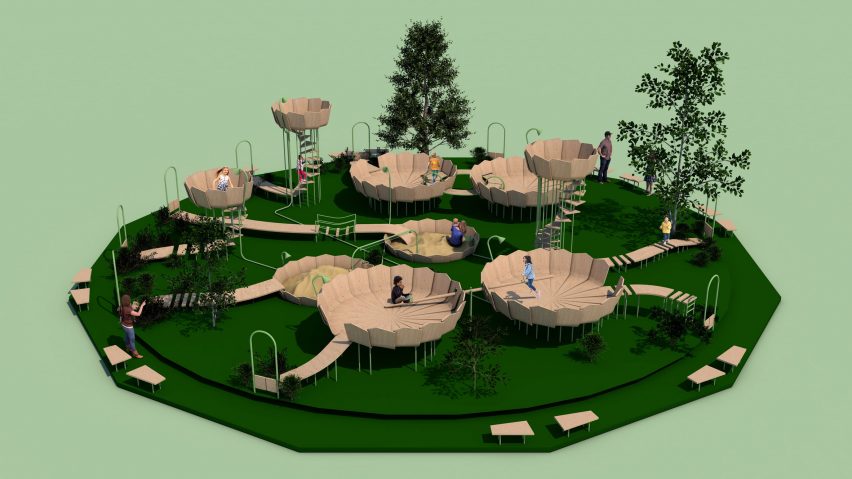Berlin-based designers Martin Binder and Claudio Rimmele have designed a concept for an "infection-free" playground where children could play together safely during the coronavirus pandemic.
Rising to the "creative challenge" of the pandemic, designer Binder and psychologist Rimmele set out to solve the problem of creating a space that both protects its users from potential contagions while still enabling fun interactions.
The resulting Rimbin concept is a playground made up of a group of individual play areas shaped like a cluster of water-lily pads on a pond.
Each child can have their own playing platform, with individual paths leading to separate entrances, from which they can see and communicate with each other from a safe distance.
Users can see when an area is occupied from the entrance gate. Once inside the platform, children can communicate with one another between areas by speaking into hollow tubes.
The play platforms can accommodate different types of activities and games. Some contain sand, while others have seesaws, ladders or "horizontal hamster wheels" inside.
Elements that are exposed to direct contact with the children, like handles and tubes, are made from metal in order to be easily sanitised. The duo propose installing disinfectant dispensers to aid this cleaning process.
"Even though playgrounds have reopened in Germany, playing together with unknown children cannot be as relaxed, for the time being, without risking infection," said the creators.
"Children need interactive outdoor play," they continued. "For them, the social and physical stimuli are necessary for physical and mental development, and to learn important social skills."
In order to better understand the needs of both parents and their children, Binder and Rimmele conducted telephone interviews with adults and kids who described their daily life during lockdown.
"For most parents it was clear that a solution must be found to offer their children more physical activity with friends in nature," they said.
"An important part of the research and development was the examination of biological forms and natural materials."
The duo based the Rimbin design on the shape of the leaf of an Amazonian water lily, which is known to be able to withstand a heavy weight.
"To demonstrate the water lily's natural carrying power, the botanist Joseph Paxton placed his own daughter on the leaf of a giant water lily around 1849," the creators explained.
"Rimbin's play areas should be as safe and stable for children as these leaves," they added.
Composed of two separate words – rim, as in edge, and bin, as in container – the name Rimbin describes the concept's individual play areas. It also stands for the first syllables of each of the surnames of the designers.
Binder and Rimmele envision the playground being used both during and after the pandemic.
It comes as part of the duo's attempt to re-think, long-term, the design of playgrounds in urban areas, so that they can remain open in situations similar to the Covid-19 pandemic, should this happen again.
Many designers have been creating objects and concepts for children, to keep them entertained during the Covid-19 lockdown.
IKEA has designed six forts that can be built with its products such as tables and blankets, while Metaform Architects created face shields for children that can be customised with crowns, animal ears or googley eyes.

